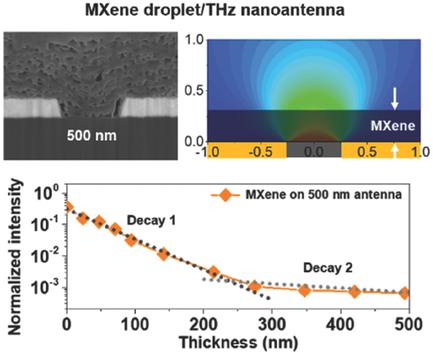当前位置:
X-MOL 学术
›
Adv. Opt. Mater.
›
论文详情
Our official English website, www.x-mol.net, welcomes your
feedback! (Note: you will need to create a separate account there.)
Enhanced Terahertz Shielding of MXenes with Nano‐Metamaterials
Advanced Optical Materials ( IF 8.0 ) Pub Date : 2018-01-16 , DOI: 10.1002/adom.201701076 Geunchang Choi 1, 2 , Faisal Shahzad 3, 4 , Young-Mi Bahk 5 , Young Min Jhon 1 , Hyunchul Park 3 , Mohamed Alhabeb 6 , Babak Anasori 6 , Dai-Sik Kim 2 , Chong Min Koo 3, 4, 7 , Yury Gogotsi 6 , Minah Seo 1
Advanced Optical Materials ( IF 8.0 ) Pub Date : 2018-01-16 , DOI: 10.1002/adom.201701076 Geunchang Choi 1, 2 , Faisal Shahzad 3, 4 , Young-Mi Bahk 5 , Young Min Jhon 1 , Hyunchul Park 3 , Mohamed Alhabeb 6 , Babak Anasori 6 , Dai-Sik Kim 2 , Chong Min Koo 3, 4, 7 , Yury Gogotsi 6 , Minah Seo 1
Affiliation

|
Terahertz (THz) shielding becomes increasingly important with the growing development of THz electronics and devices. Primarily materials based on carbon nanostructures or polymer–carbon nanocomposites have been explored for this application. Herein, significantly enhanced THz shielding efficiencies for 2D titanium carbide (Ti3C2 MXene) thin films with nanoscale THz metamaterials are presented. Nanoscale slot antenna arrays with strong resonances at certain frequencies enhance THz electromagnetic waves up to three orders of magnitude in transmission, which in turn enormously increases the shielding performance in combination with MXene films. Drop‐casting of a colloidal solution of MXene (a few micrograms of dry material) can produce an ultrathin film (several tens of nanometers in thickness) on a slot antenna array. Consequently, THz waves strongly localized in the near‐field regime by the slot antenna undergo enhanced absorption through the film with a magnified effective refractive index. Finally, the combination of an ultrathin MXene film and a nano‐metamaterial shows excellent shielding performance in the THz range.
中文翻译:

纳米材料增强MXene的太赫兹屏蔽
随着太赫兹电子产品和设备的不断发展,太赫兹(THz)屏蔽变得越来越重要。对于这种应用,主要研究了基于碳纳米结构或聚合物-碳纳米复合材料的材料。在此,显着提高了2D碳化钛(Ti 3 C 2介绍了具有纳米级太赫兹超材料的MXene薄膜。在某些频率下具有强共振的纳米级缝隙天线阵列可以将THz电磁波的传输强度提高到三个数量级,从而与MXene薄膜结合使用时,极大地提高了屏蔽性能。MXene(几微克干物质)的胶体溶液的滴铸可以在缝隙天线阵列上产生超薄薄膜(厚度几十纳米)。因此,由缝隙天线在近场状态下强定位的太赫兹波通过有效折射率增大的薄膜吸收了增强的光。最后,超薄MXene膜和纳米金属材料的组合在THz范围内显示出出色的屏蔽性能。
更新日期:2018-01-16
中文翻译:

纳米材料增强MXene的太赫兹屏蔽
随着太赫兹电子产品和设备的不断发展,太赫兹(THz)屏蔽变得越来越重要。对于这种应用,主要研究了基于碳纳米结构或聚合物-碳纳米复合材料的材料。在此,显着提高了2D碳化钛(Ti 3 C 2介绍了具有纳米级太赫兹超材料的MXene薄膜。在某些频率下具有强共振的纳米级缝隙天线阵列可以将THz电磁波的传输强度提高到三个数量级,从而与MXene薄膜结合使用时,极大地提高了屏蔽性能。MXene(几微克干物质)的胶体溶液的滴铸可以在缝隙天线阵列上产生超薄薄膜(厚度几十纳米)。因此,由缝隙天线在近场状态下强定位的太赫兹波通过有效折射率增大的薄膜吸收了增强的光。最后,超薄MXene膜和纳米金属材料的组合在THz范围内显示出出色的屏蔽性能。









































 京公网安备 11010802027423号
京公网安备 11010802027423号